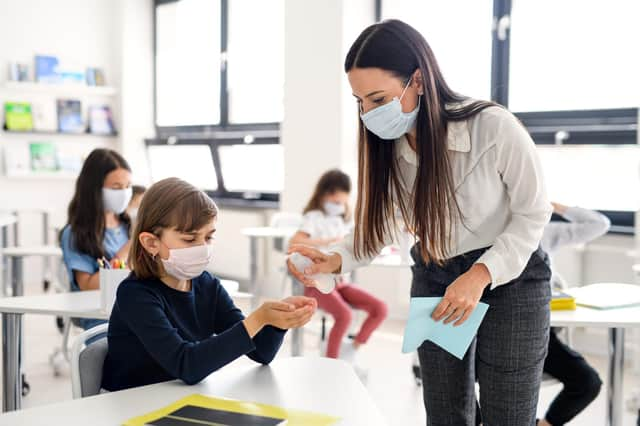This is how rapid Covid testing of pupils will work - and the risk of infection for teachers in school


The risk of Covid infection for teachers and school staff has been revealed ahead of the return of all pupils to the classroom on 8 March.
A survey conducted by the Office of National Statistics (ONS) looked at the number of school staff which tested positive for coronavirus antibodies in December.
Advertisement
Hide AdAdvertisement
Hide AdThe level of antibodies, which indicate a past infection of Covid, were then compared to other working-age adults to give an indication of how prevalent the virus is in schools.
It comes after it emerged families with children in school will have access to Covid tests twice a week from home, as the government looks to safely reopen classrooms amid the pandemic.
How will home testing for pupils’ families work?
Pupils’ households, as well as those in their childcare or support bubbles, will be provided with free Covid tests regardless of whether anyone has symptoms.
The rapid tests will be ordered and collected from local sites or administered through workplace testing programmes, said the Department of Health and Social Care (DHSC)
Advertisement
Hide AdAdvertisement
Hide AdSecondary and college pupils will be tested with lateral flow tests twice a week, receiving three initial tests at school before they start taking them at home.
Families with college-aged teenagers who are not studying are not included in the plans.
The twice-weekly tests will also be offered to adults working with schools, such as bus drivers and after school club leaders.
Are lateral flow tests compulsory?
Health secretary Matt Hancock said it was another way to keep schools safe.
Advertisement
Hide AdAdvertisement
Hide Ad“Regular testing of households and childcare support bubbles of primary and secondary school children is another tool we are making available to help keep schools safe,” he said.
“We know that one in three people with Covid-19 don’t have any symptoms, so targeted, regular testing will mean more positive cases are kept out of schools and colleges.”
Labour’s shadow education secretary Kate Green said: “School testing will not work if families struggling financially are too scared about losing out on income to take the tests.
“If the Government is serious about using testing to help get all children back to school they must improve self-isolation support by extending eligibility for the £500 Test and Trace Support Payment to anyone without access to workplace sick pay.”
What risk is there of catching Covid in school for staff?
Advertisement
Hide AdAdvertisement
Hide AdThe ONS study involved 12,203 staff and pupils being tested on site across 121 schools at least once between 2 and 10 December 2020.
It found that school staff are not at a higher risk of Covid infection than other working-age adults in their local communities.
Around 14.99% of school staff tested positive for coronavirus antibodies - lower than the estimate of 18.22% for working-age adults.
It also suggested the proportion of staff who tested positive for Covid antibodies was 14.61% of primary staff, compared with 15.72% of secondary staff.
Advertisement
Hide AdAdvertisement
Hide AdThe data comes in the wake of the Government outlining its Phase 2 of the Covid vaccination rollout, which didn’t prioritise teachers or any other specific occupations.
What have the experts said about schools reopening?
Dr Shamez Ladhani, a PHE consultant epidemiologist and the study’s chief investigator, said it was “extremely reassuring” that teachers do not appear to be at a higher risk of infection than working people of the same age.
“At the end of the day it’s very, very dependent on community infection rates as to what happens with schools,” said Dr Ladhani reflecting on the ONS study.
“It’s not just about the schools. It’s about going to schools, it’s about parents actually using public transport to get their children to schools, it is about meeting and picking them up so the whole process of schooling comes with a small risk.
Advertisement
Hide AdAdvertisement
Hide Ad“It would be very naive to think that opening schools will not result in any changes in R rates or infection rates, but the bottom line is that the benefits of bringing children back to school far outweigh any risks that we see with Covid.”